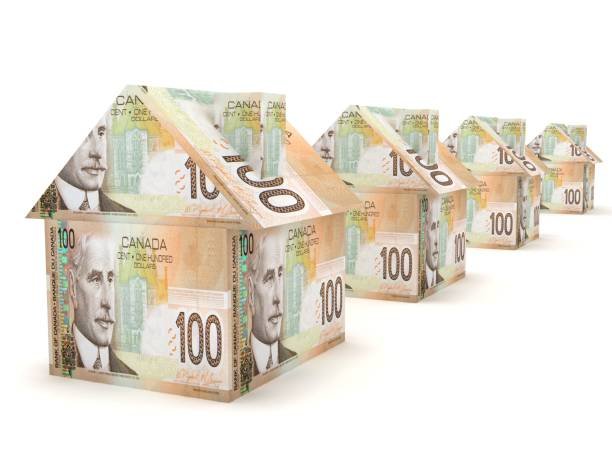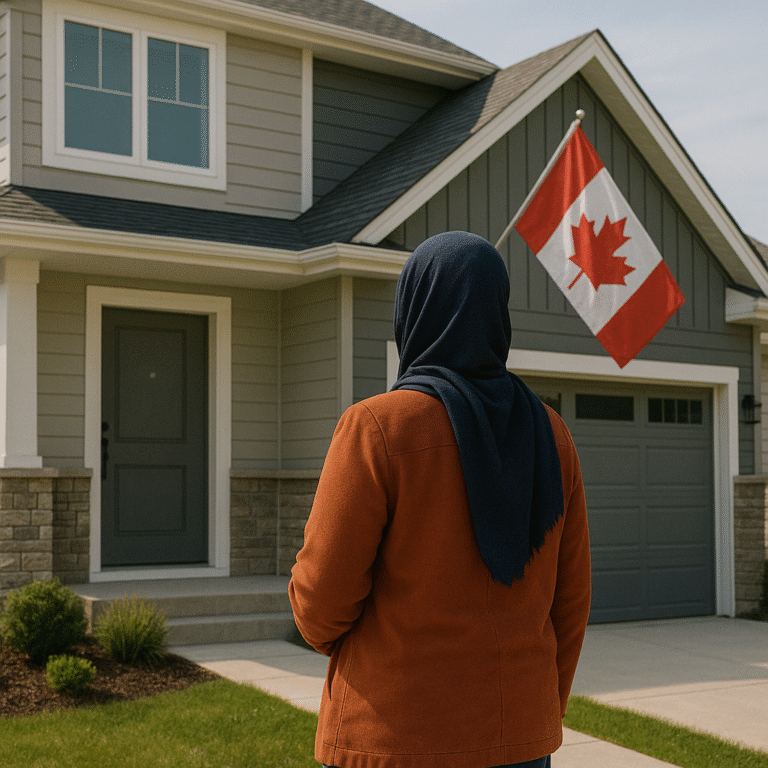
How to Apply for a Mortgage in Canada (2025): A Beginner’s Guide
Buying your first home in Canada? The mortgage process can feel like a maze — credit checks, pre-approvals, paperwork, and big financial words you’ve never heard before. But don’t worry. This beginner’s guide will walk you through every step of applying for a mortgage in 2025, in plain language. Think of it as your personal playbook — one that takes the stress out and replaces it with confidence.
What Is a Mortgage Application?
A mortgage application is your official request to borrow money from a lender (like a bank or credit union) to help you buy a home. It’s not just a form — it’s your financial story. The lender uses it to decide if they’ll give you the money, how much, and at what interest rate.
Step 1: Figure Out How Much You Can Afford
Before you even speak to a lender, take a good look at your finances. How much money do you make each month? How much debt are you carrying? Use an online affordability calculator to estimate what home price range fits your budget.
🏠 Mortgage Affordability Calculator
💡 Note: This is a simplified tool. Your actual qualification depends on the mortgage stress test, credit score, and lender guidelines.
Step 2: Get Pre-Approved — Not Just Pre-Qualified
Pre-qualification is a quick estimate based on numbers you give verbally. Pre-approval, on the other hand, is the real deal — a lender actually checks your credit score, income, debts, and issues a written letter showing how much they’re willing to lend you.
This letter makes you look serious to sellers and gives you a realistic home search range.
📄 Sample Mortgage Pre-Approval Letter Layout
Wondering what a mortgage pre-approval letter actually looks like? Here’s a simple example — plus a quick checklist to make sure yours includes everything lenders and sellers expect.
From: Maple Ridge Mortgage Ltd.
123 Main Street, Toronto, ON
Date: June 24, 2025
To: Priya Sharma
456 Oak Lane, Mississauga, ON
Dear Priya,
Congratulations! Based on the financial information you shared with us — including income, credit history, and down payment — you’re officially pre-approved for a mortgage.
Here are the key details of your pre-approval:
- Home Budget: Up to $700,000
- Pre-Approved Mortgage: $560,000
- Verified Down Payment: $140,000 (20%)
- Mortgage Type: 5-Year Fixed
- Estimated Interest Rate: 5.09% (may vary)
- Amortization Period: 25 Years
- Pre-Approval Valid Until: September 22, 2025
Just a reminder — this pre-approval is conditional. It depends on a successful property appraisal and continued verification of your income, credit score, and job status.
All the best as you begin your home search!
Sincerely,
Jasleen Kaur
Senior Mortgage Advisor
Maple Ridge Mortgage Ltd.
🧾 What Should Be in Your Pre-Approval Letter?
- ✔️ Lender’s name and contact details
- ✔️ Your full name (and ideally, a client reference number)
- ✔️ Maximum mortgage amount + purchase price range
- ✔️ Interest rate offered and amortization term
- ✔️ Verified down payment amount
- ✔️ Expiry date (how long the pre-approval is valid)
- ✔️ Any conditions or disclaimers (e.g. subject to appraisal)
💡 Tip: Always ask for your pre-approval letter in writing — it shows sellers you’re a serious buyer and can strengthen your offer in a competitive market.
Step 3: Gather Your Mortgage Documents
To apply for a mortgage, you’ll need to prove your income, identity, and financial history. Most lenders will ask for:
– Your last 2–3 pay stubs
– Your last 2 years’ T4s or NOAs
– A letter of employment
– Recent bank statements
– Photo ID and SIGN
If you’re self-employed, expect to also provide tax returns, business registration, and financial statements.
📂 Mortgage Pre-Approval: Required Documents
To get pre-approved in Canada, most lenders will ask you for the following documents. Make sure you’re ready!
Government ID
Driver’s licence or passport to confirm identity
Proof of Employment
Recent pay stubs or job letter from employer
Income Verification
T4s, NOAs, or tax returns (last 2 years)
Bank Statements
Show savings, down payment source, and debts
Credit Report
Lender will pull it — but know your score
💡 Pro Tip: Organize your documents in a single PDF or folder to speed up the approval process.
Step 4: Shop Around for Lenders or Use a Broker
Don’t just walk into your local bank and accept the first rate they offer. Every lender has different products, rates, and approval rules.
You can either:
– Compare rates online
– Talk to multiple banks
– Use a mortgage broker (they do the shopping for you and often get better deals)
A broker can be especially helpful if you have less-than-perfect credit, are self-employed, or are a newcomer to Canada.
Step 5: Submit the Mortgage Application
Once you’ve chosen a lender or broker, it’s time to submit your full mortgage application. This includes:
– Your basic info (name, address, SIN)
– Employment and income details
– Property details (once you’ve made an offer)
– All your documents from earlier
The lender will also pull your credit report at this stage.
Step 6: Wait for the Approval — and Conditions
This part usually takes a few days. If all looks good, the lender will issue a **conditional approval** — meaning you’re approved if you meet certain terms. This could include:
– An appraisal of the property
– Proof of down payment
– Extra documents, like gift letters if your parents are helping with funds
Once you meet all the conditions, you’ll get the final approval.
Once you’ve submitted your application, the next big step is approval — here’s what lenders will look for.
Not sure if your income qualifies? This guide breaks down the income you’ll need to meet mortgage requirements in 2025.
Real-Life Example: How Rhea Got Her First Mortgage Right
Rhea was a first-time buyer in Vancouver. She had a decent salary but didn’t know where to start. Her broker helped her get pre-approved before she even started house-hunting.
When she found a two-bedroom condo, she already had her documents ready. The lender approved her in 3 days. Since she locked in her rate early, she saved over $4,000 in interest by the time she closed.
Her tip? “Get pre-approved and organized before you fall in love with a place.”
What Happens After You’re Approved?
Once you’re fully approved, the lender sends the mortgage paperwork to your lawyer. You’ll meet to sign everything, pay your down payment, and provide proof of insurance.
Your lawyer handles the money transfer, title registration, and all the legal stuff. On closing day, you get your keys — and you’re officially a homeowner.
📆 Timeline: From Mortgage Approval to Closing Day
Wondering what happens after your mortgage is approved? Here’s a simple timeline of key milestones leading to closing.
✅ Step 1: Mortgage Approval
Lender issues final approval after reviewing documents, appraisal, and credit.
📑 Step 2: Sign the Mortgage Commitment
You review and sign your lender’s formal offer and conditions.
🧾 Step 3: Work With Your Lawyer
Your real estate lawyer handles title search, registration, and coordinates with lender and seller.
💸 Step 4: Final Payment + Closing Costs
You send your down payment, closing costs, and lawyer fees to your solicitor’s trust account.
🏡 Step 5: Closing Day!
Ownership transfers, mortgage funds are released, and you get the keys to your new home!
⏱️ The full process from approval to keys typically takes 2–4 weeks, depending on your deal and lender.
Final Thoughts from a Mortgage Expert
Getting a mortgage in Canada can feel intimidating, but it doesn’t have to be. Start early, get organized, and don’t be afraid to ask questions.
The best thing you can do? Talk to a mortgage broker. They’ll guide you through each step, help you avoid costly mistakes, and make sure your mortgage actually fits your lifestyle — not just the numbers on paper.
A little preparation today can save you thousands tomorrow. Now you know exactly what it takes to apply for a mortgage in 2025 — and you’re one big step closer to homeownership.
Stuck with a Mortgage Decision?
Don’t stress — our team is here to help. Reach out for free, no-obligation guidance.
Contact the Experts



